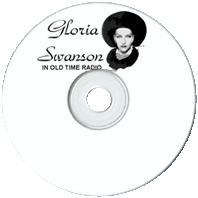

If there ever was a grande dame of Hollywood, it would have been Gloria Swanson.

11 old time radio show recordings
(total playtime 7 hours, 41 min)
available in the following formats:
1 MP3 CD
or
6 Audio CDs
Text on OTRCAT.com ©2001-2025 OTRCAT INC All Rights Reserved. Reproduction is prohibited.
Gloria Swanson
(1899 – 1983)

Gloria was born in Chicago, a soldier's daughter, in 1899. Joseph Svennsson's career took the family south to Puerto Rico and Key West, where Gloria spent most of her childhood and developed a love of performing. With her attractive singing voice, fashion sense and good looks (although her mother always said her ears were too big), Gloria was a hit in school productions and operettas. One of her earliest ambitions was to become an opera singer.
Gloria and her mother eventually returned to Chicago while her father's duties kept him overseas. At the age of 15, one of Gloria's aunts took her to Essanay Studios on a lark. Her good looks and smart clothes caught a director's eye, and soon Gloria was performing in two-reelers.

Gloria met Wallace Beery at Essanay's Chicago Studios. He became her first husband and convinced her to move to Hollywood. They were married on her 17th birthday, but Gloria's relationship with Hollywood was much more successful than with her husband. She became one of Tinseltown's most sought after stars, and her services were so valued by Paramount that the studio gave into most of her whims.
Gloria became the screen's first clotheshorse. She was often bedecked in beads, jewels, peacock and ostrich feathers and whatever else haute couture designers could come up with. It is a credit to her acting that Gloria with her barely five foot frame was able to outshine the finery. She became a favored star for director and Cecil B. DeMille at Paramount.
In 1925 she traveled to France to film Madame Sans-Gene. While there she fell in love with the production's interpreter, Henri, Marquis de la Falaise, who became her third husband. As the first American screen princess to marry into the nobility, her popularity soared again.
Gloria chose to leave paramount to produce her own films through United Artists. She was determined to make the controversial Sadie Thompson which had been banned by the Hays Committee and blacklisted by the major studios. Joseph Kennedy (father of the future President and Attorney General) helped to finance several projects, including Sadie Thompson, which went on to become a financial success.

After the financial disaster of Queen Kelly, Kennedy returned to his wife and left Gloria in worse financial shape than when they met. Gloria was able to make the transition to talkies, but her career began to decline.
As her success with movies began to wane, Gloria moved full time to New York, where she occasionally found radio work along with her other projects, including an appearance on Texaco Town and a guest appearance on The Adventures of Ellery Queen in "The Scarecrow and the Snowman".
During the War Gloria ran an invention and patent company in New York called Multiprizes, but the company's real mission was getting Jewish inventors and scientists out of Europe. She began appearing in legitimate theater and began painting and sculpting.
Gloria was one of television's earliest stars, hosting The Gloria Swanson Hour in 1948. She stayed away from pictures until 1950 when she was cast in one of her best known roles, aging silent film star .Norma Desmond in Sunset Boulevard.
Gloria Swanson passed away in New York in 1983. Two Stars on the Hollywood Walk of Fame honor her, one at 6748 Hollywood Blvd for her work in Motion Pictures and another at 6301 Hollywood Blvd for her work in Television. A parking lot in New Port Richey, Florida, bears the name The Gloria Swanson Parking Area because the star had a home on the banks of the Cotee River.

Text on OTRCAT.com ©2001-2025 OTRCAT INC All Rights Reserved. Reproduction is prohibited.
You have reached the maximum number of votes for a unregistered user.
Please login or create a new account to continue...
You have reached the maximum number to down votes in this page.



Gloria Swanson Disc A001
|
Add Audio CD to Cart - $5.00 |
Gloria Swanson Disc A002
|
Add Audio CD to Cart - $5.00 |
Gloria Swanson Disc A003
|
Add Audio CD to Cart - $5.00 |
Gloria Swanson Disc A004
|
Add Audio CD to Cart - $5.00 |
Gloria Swanson Disc A005
|
Add Audio CD to Cart - $5.00 |
Gloria Swanson Disc A006
|
Add Audio CD to Cart - $5.00 |
Please wait...
COMMENTS
Be the first to comment on "Gloria Swanson"
Leave a comment